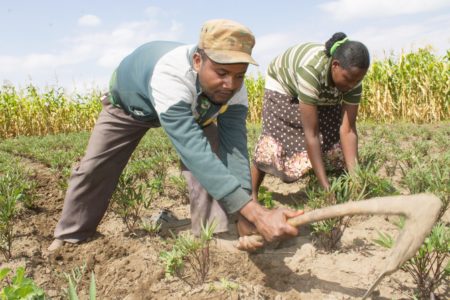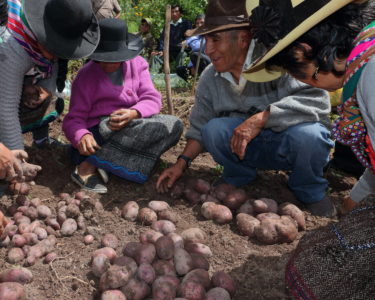
Recent reports that greenhouse gases in the atmosphere have reached record high levels and that the world is currently on track to overshoot the targets of the Paris Agreement heighten the importance of developing technologies to help farmers adapt to climate change. This is especially urgent for the poorest and most vulnerable farmers, who already struggle to produce enough food.
In order to achieve food and nutrition security for the world’s poor, agriculture has become a priority area for climate action for many developing countries. To support such efforts, CGIAR Centers and Research Programs identified 10 best bet innovations for adaptation in agriculture, which can help countries achieve food security under a changing climate, while also delivering benefits for environmental sustainability, nutrition and livelihoods. This includes the development and deployment of stress tolerant root, tuber and banana crops, innovations that are being driven by the CGIAR Research Program on Roots, Tubers and Bananas (RTB) and its lead center, the International Potato Center (CIP).
Why root and tuber crops?

More than 300 million people living below the poverty line in developing countries depend on root, tuber and banana crops for food and income, particularly in Africa, Asia and the Americas.
These crops, which include banana, cassava, potato, sweetpotato and yam, have immense potential for reducing hunger and malnutrition and helping smallholder farmers adapt to climate change. A major advantage lies in their resilience and ability to produce nutritious food in less time than many other crops. They are thus particularly critical for food security in Africa and will become even more fundamental in the coming decades as the continent undergoes rapid urbanization and population growth.
“With climate change, varieties will need to respond to hotter and drier conditions, but also more weather variability and extreme events, higher salinity with rising sea levels and more attacks from pest and diseases as higher temperatures increase incidence and severity,” notes Hugo Campos, Director for Research at CIP.
To improve farmers’ capacities to produce more nutritious food in a climate-changing world, CIP and the other RTB Centers are undertaking groundbreaking research to improve RTB crops, seed systems, pest and disease management and postharvest innovations.
Climate-smart breeding
With improved varieties needed urgently, scientists are raising the bar for breeding a next generation of RTB crops that are more climate-resilient, nutritious and desirable to local consumers.

CIP has promoted an accelerated breeding scheme that cuts the time it takes to develop and release a new variety from eight years to four. In Mozambique, this approach led to the released of 15 pro-vitamin A rich, drought tolerant orange-fleshed sweetpotato varieties in 2011 and an additional four varieties in 2016. Those climate-resilient varieties now constitute about one third of the sweetpotatoes grown in Mozambique, a country where extreme weather events frequently destroy crops. One of them, Irene, is especially popular because its narrow leaves can be eaten as a vegetable 60 days after planting, and its delicious orange-fleshed roots are ready to harvest after 100 days.
Breeders have likewise developed potato varieties tolerant to drought, heat and salinity, such as the widely cultivated Unica and Tacna, developed and field tested in Peru; Kinga, Meva, Kinigi varieties in Africa; and the Raniag variety in the Philippines. Tacna, which was introduced to China under the name Jizhangshu 8, covered over 20,000 ha there in 2008. More recently developed climate change resilient potatoes include the drought- and soil salinity-tolerant variety Sarnav, released in Central Asia (Uzbekistan and Tajikistan) and the heat and soil salinity-tolerant BARI Alu-72, released in Bangladesh.
“RTB breeding has already begun to modernize, but climate change is moving the goal posts so we need to change a whole lot faster, better, and smarter,” says Graham Thiele, Program Director, CGIAR Research Program on RTB.
Graham and other RTB scientists have proposed a six-step framework for climate-smart breeding that involves downscaling climate change models and crop modeling to look into the future and anticipate the kinds of varieties needed in 20 and 50 years. The framework also includes identifying and understanding key climate change responsive traits and transforming breeding and varietal selection by drawing on increased knowledge of the genome with next generation tools such as gene editing. Big data should also be harnessed to understand how varieties respond in different environments to accelerate genetic gains, and management options developed for climate-smart varieties. The framework also highlights the need for climate-proofing seed systems so that new varieties can reach growers and consumers.
Climate smart seed systems
As new varieties are released, managing seed systems is crucial for ensuring that farmers adopt them and maintain quality planting material in the face of increasing incidences of drought and floods.
Sweetpotato farmers plant vine cuttings, and prolonged dry periods can result in widespread shortages of that perishable planting material in sub-Saharan Africa. CIP researchers are thus promoting a practice that allows farmers to produce their own vines in time for the planting season. Known as Triple S – for storage in sand and sprouting – it consists of storing sweetpotato roots in dry sand following the harvest, planting them in seedbeds six to eight weeks before the rainy season, and watering them to produce enough vines to plant when the rains begin. With support from RTB, researchers are scaling this technology, which can result in earlier harvests, providing food and income at a time that is commonly known as “the hunger season”.
In order to maintain disease-free planting material, farmers in high virus pressure areas are using net tunnels to guard against insect vectors such as aphids and whiteflies, which spread viruses. The net tunnels are effective in reducing infection by sweetpotato virus disease, ensuring availability of clean planting material for higher yield. Such tunnels also contribute towards moisture retention, reducing the amount of water needed for irrigation.
Moving ahead
As climate change deepens food insecurity through factors such as yield losses, the need for crop tolerance to climatic stresses will be greater than ever. Whether it’s early maturing or stress tolerant varieties, the need for more resilient RTB crops is increasingly urgent. Funding for enhanced breeding systems will be crucial for deploying promising next generation technologies to tackle climate change in agriculture.
Blog by Vivian Atakos with contributions from Graham Thiele, Hugo Campos, Michael Friedmann, Holly Holmes and David Dudenhoefer
